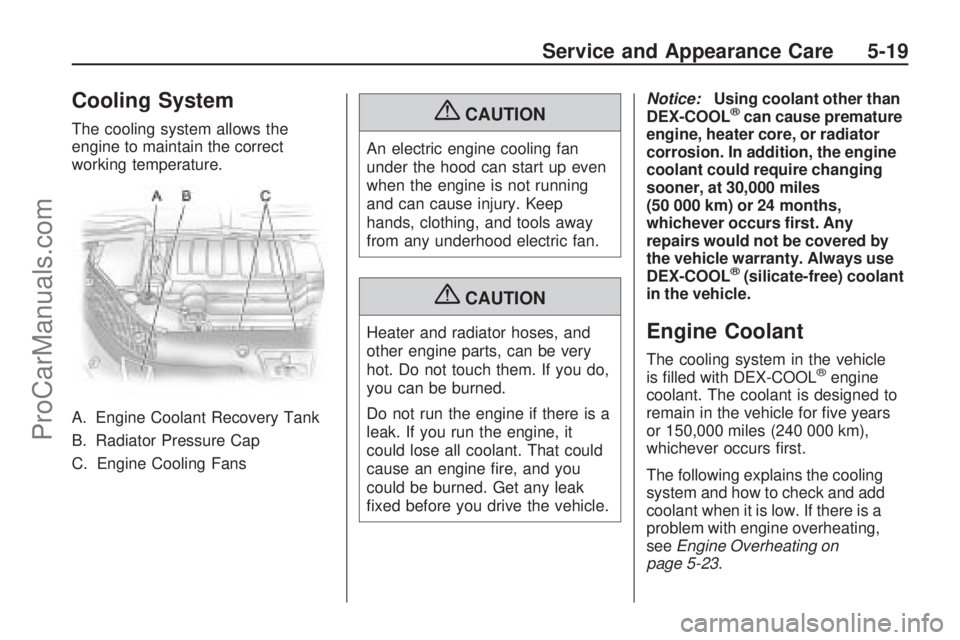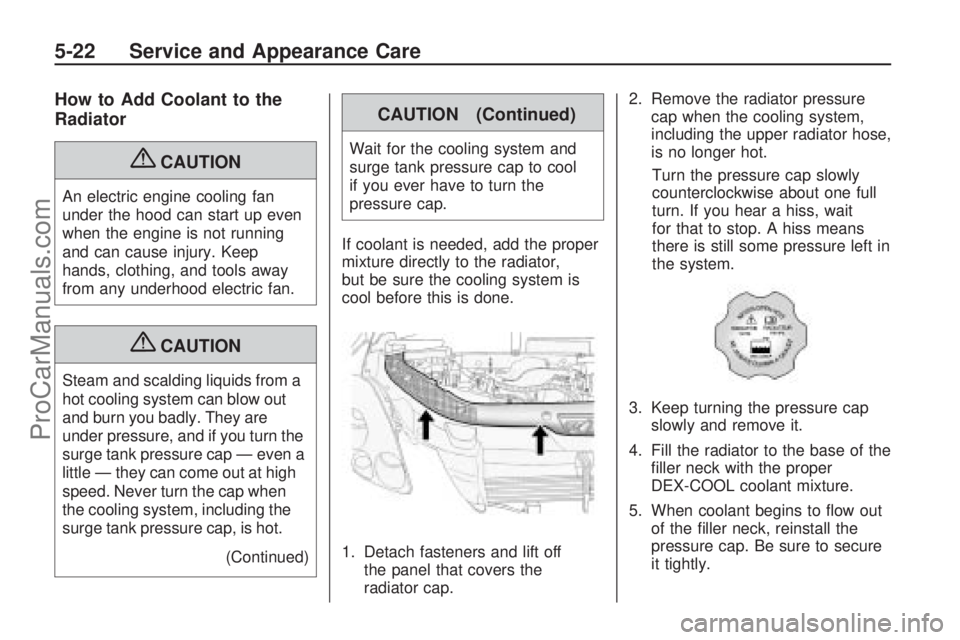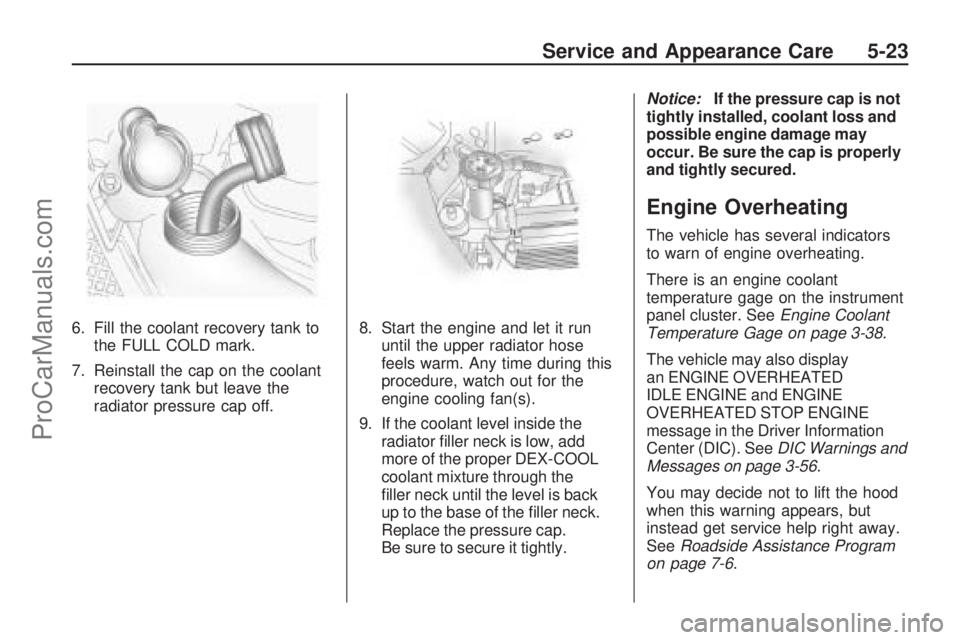radiator SATURN OUTLOOK 2009 Owners Manual
[x] Cancel search | Manufacturer: SATURN, Model Year: 2009, Model line: OUTLOOK, Model: SATURN OUTLOOK 2009Pages: 432, PDF Size: 2.48 MB
Page 299 of 432

A. Radiator Pressure Cap. See
Cooling System on page 5-19.
B. Engine Coolant Recovery Cap.
SeeCooling System on
page 5-19.
C. Remote Negative (−) Terminal.
SeeJump Starting on page 5-30.
D.Underhood Fuse Block on
page 5-94.
E. Remote Positive (+) Terminal.
SeeJump Starting on page 5-30.
F.Power Steering Fluid on
page 5-25.
G. Engine Oil Fill Cap. See “When
to Add Engine Oil” underEngine
Oil on page 5-13.H. Engine Oil Dipstick. See
“Checking Engine Oil” under
Engine Oil on page 5-13.
I. Automatic Transmission Fluid
Dipstick. See “Checking the
Fluid Level” underAutomatic
Transmission Fluid on page 5-18.
J. Brake Master Cylinder Reservoir.
See “Brake Fluid” underBrakes
on page 5-27.
K.Engine Air Cleaner/Filter on
page 5-17.
L. Windshield Washer Fluid
Reservoir. See “Adding Washer
Fluid” underWindshield
Washer Fluid on page 5-26.Engine Oil
Checking Engine Oil
It is a good idea to check the engine
oil level at each fuel �ll. In order to
get an accurate reading, the oil must
be warm and the vehicle must be on
level ground.
The engine oil dipstick handle
is a yellow loop. SeeEngine
Compartment Overview on
page 5-12for the location of the
engine oil dipstick.
1. Turn off the engine and give the
oil several minutes to drain back
into the oil pan. If this is not done,
the oil dipstick might not show the
actual level.
2. Pull out the dipstick and clean
it with a paper towel or cloth,
then push it back in all the way.
Remove it again, keeping the
tip down, and check the level.
Service and Appearance Care 5-13
ProCarManuals.com
Page 305 of 432

Cooling System
The cooling system allows the
engine to maintain the correct
working temperature.
A. Engine Coolant Recovery Tank
B. Radiator Pressure Cap
C. Engine Cooling Fans{CAUTION
An electric engine cooling fan
under the hood can start up even
when the engine is not running
and can cause injury. Keep
hands, clothing, and tools away
from any underhood electric fan.
{CAUTION
Heater and radiator hoses, and
other engine parts, can be very
hot. Do not touch them. If you do,
you can be burned.
Do not run the engine if there is a
leak. If you run the engine, it
could lose all coolant. That could
cause an engine �re, and you
could be burned. Get any leak
�xed before you drive the vehicle.Notice:Using coolant other than
DEX-COOL
®can cause premature
engine, heater core, or radiator
corrosion. In addition, the engine
coolant could require changing
sooner, at 30,000 miles
(50 000 km) or 24 months,
whichever occurs �rst. Any
repairs would not be covered by
the vehicle warranty. Always use
DEX-COOL
®(silicate-free) coolant
in the vehicle.
Engine Coolant
The cooling system in the vehicle
is �lled with DEX-COOL®engine
coolant. The coolant is designed to
remain in the vehicle for �ve years
or 150,000 miles (240 000 km),
whichever occurs �rst.
The following explains the cooling
system and how to check and add
coolant when it is low. If there is a
problem with engine overheating,
seeEngine Overheating on
page 5-23.
Service and Appearance Care 5-19
ProCarManuals.com
Page 306 of 432

What to Use
{CAUTION
Adding only plain water to the
cooling system can be dangerous.
Plain water, or some other liquid
such as alcohol, can boil before
the proper coolant mixture will.
The vehicle’s coolant warning
system is set for the proper
coolant mixture. With plain water
or the wrong mixture, the engine
could get too hot but you would
not get the overheat warning.
The engine could catch �re and
you or others could be burned.
Use a 50/50 mixture of clean,
drinkable water and DEX-COOL
®
coolant.Use a 50/50 mixture of clean,
drinkable water and DEX-COOL
coolant. If using this mixture,
nothing else needs to be added.
This mixture:
Gives freezing protection
down to−34°F (−37°C), outside
temperature.
Gives boiling protection up
to 265°F (129°C), engine
temperature.
Protects against rust and
corrosion.
Will not damage aluminum parts.
Helps keep the proper engine
temperature.Notice:If an improper coolant
mixture is used, the engine could
overheat and be badly damaged.
The repair cost would not be
covered by the vehicle warranty.
Too much water in the mixture
can freeze and crack the engine,
radiator, heater core, and other
parts.
Notice:If extra inhibitors
and/or additives are used in the
vehicle’s cooling system, the
vehicle could be damaged. Use
only the proper mixture of the
engine coolant listed in this
manual for the cooling system.
SeeRecommended Fluids and
Lubricants on page 6-12for more
information.
5-20 Service and Appearance Care
ProCarManuals.com
Page 308 of 432

How to Add Coolant to the
Radiator
{CAUTION
An electric engine cooling fan
under the hood can start up even
when the engine is not running
and can cause injury. Keep
hands, clothing, and tools away
from any underhood electric fan.
{CAUTION
Steam and scalding liquids from a
hot cooling system can blow out
and burn you badly. They are
under pressure, and if you turn the
surge tank pressure cap — even a
little — they can come out at high
speed. Never turn the cap when
the cooling system, including the
surge tank pressure cap, is hot.
(Continued)
CAUTION (Continued)
Wait for the cooling system and
surge tank pressure cap to cool
if you ever have to turn the
pressure cap.
If coolant is needed, add the proper
mixture directly to the radiator,
but be sure the cooling system is
cool before this is done.
1. Detach fasteners and lift off
the panel that covers the
radiator cap.2. Remove the radiator pressure
cap when the cooling system,
including the upper radiator hose,
is no longer hot.
Turn the pressure cap slowly
counterclockwise about one full
turn. If you hear a hiss, wait
for that to stop. A hiss means
there is still some pressure left in
the system.
3. Keep turning the pressure cap
slowly and remove it.
4. Fill the radiator to the base of the
�ller neck with the proper
DEX-COOL coolant mixture.
5. When coolant begins to �ow out
of the �ller neck, reinstall the
pressure cap. Be sure to secure
it tightly.
5-22 Service and Appearance Care
ProCarManuals.com
Page 309 of 432

6. Fill the coolant recovery tank to
the FULL COLD mark.
7. Reinstall the cap on the coolant
recovery tank but leave the
radiator pressure cap off.8. Start the engine and let it run
until the upper radiator hose
feels warm. Any time during this
procedure, watch out for the
engine cooling fan(s).
9. If the coolant level inside the
radiator �ller neck is low, add
more of the proper DEX-COOL
coolant mixture through the
�ller neck until the level is back
up to the base of the �ller neck.
Replace the pressure cap.
Be sure to secure it tightly.Notice:If the pressure cap is not
tightly installed, coolant loss and
possible engine damage may
occur. Be sure the cap is properly
and tightly secured.
Engine Overheating
The vehicle has several indicators
to warn of engine overheating.
There is an engine coolant
temperature gage on the instrument
panel cluster. SeeEngine Coolant
Temperature Gage on page 3-38.
The vehicle may also display
an ENGINE OVERHEATED
IDLE ENGINE and ENGINE
OVERHEATED STOP ENGINE
message in the Driver Information
Center (DIC). SeeDIC Warnings and
Messages on page 3-56.
You may decide not to lift the hood
when this warning appears, but
instead get service help right away.
SeeRoadside Assistance Program
on page 7-6.
Service and Appearance Care 5-23
ProCarManuals.com
Page 391 of 432

Additional Required Services (cont’d)
Service and Miles (Kilometers)25,000
(40 000) 50,000
(80 000) 75,000
(120 000) 100,000
(160 000) 125,000
(200 000) 150,000
(240 000)
Replace spark plugs and inspect spark
plug wires. An Emission Control
Service. •
Engine cooling system service
(or every �ve years, whichever occurs
�rst). An Emission Control Service.
See footnote (i). •
Inspect engine accessory drive belt.
An Emission Control Service.
See footnote (k). •
Maintenance Footnotes
(a)
Visually inspect brake lines and
hoses for proper hook-up, binding,
leaks, cracks, chafing, etc. Inspect
disc brake pads for wear and rotors
for surface condition. Inspect other
brake parts, including calipers,
parking brake, etc. Check parking
brake adjustment. (b)
Visually inspect front and rear
suspension and steering system for
damaged, loose, or missing parts
or signs of wear. Inspect power
steering lines and hoses for proper
hook-up, binding, leaks, cracks,
chafing, etc. (c)
Visually inspect hoses and have
them replaced if they are cracked,
swollen, or deteriorated. Inspect all
pipes, fittings and clamps; replace
with genuine parts as needed.
To help ensure proper operation, a
pressure test of the cooling system
and pressure cap and cleaning
the outside of the radiator and
air conditioning condenser is
recommended at least once a year.
Maintenance Schedule 6-7
ProCarManuals.com
Page 392 of 432

(d)Inspect wiper blades for wear,
cracking, or contamination. Clean
the windshield and wiper blades,
if contaminated. Replace wiper
blades that are worn or damaged.
See Windshield Wiper Blade
Replacement on page 5-38 and
Windshield, Backglass, and Wiper
Blades on page 5-88 for more
information.
(e)Make sure the safety belt
reminder light and safety belt
assemblies are working properly.
Look for any other loose or damaged
safety belt system parts. If you see
anything that might keep a safety belt
system from doing its job, have it
repaired. Have any torn or frayed
safety belts replaced. Also see
Checking the Restraint Systems
on page 1-61.(f)Lubricate all key lock cylinders,
hood latch assemblies, secondary
latches, pivots, spring anchor
and release pawl, hood and door
hinges, rear folding seats, and
liftgate hinges. More frequent
lubrication may be required when
exposed to a corrosive environment.
Applying silicone grease on
weatherstrips with a clean cloth will
make them last longer, seal
better, and not stick or squeak.
(g)A fluid loss in any vehicle
system could indicate a problem.
Have the system inspected
and repaired and the fluid level
checked. Add fluid if needed.(h)Change automatic transmission
fluid if the vehicle is mainly driven
under one or more of these
conditions:
�In heavy city traffic where the
outside temperature regularly
reaches 90°F (32°C) or higher.
�In hilly or mountainous terrain.
�When doing frequent trailer
towing.
�Uses such as found in taxi, police,
or delivery service.
(i)Drain, flush, and refill cooling
system. This service can be
complex; you should have your
dealer/retailer perform this service.
See Engine Coolant on page 5-19 for
what to use. Inspect hoses. Clean
radiator, condenser, pressure cap,
and filler neck. Pressure test the
cooling system and pressure cap.
6-8 Maintenance Schedule
ProCarManuals.com